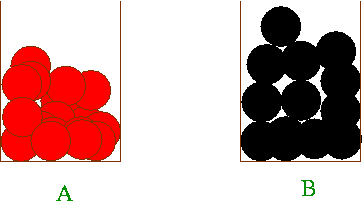Problem of the Month-August
 |
|
Suppose Farrah gives you two bags. Bag A, contains 50 Red balls and
Bag B, contains 50 Black Balls. She leaves the room asking you to
rearrange the balls between the bags in any way you want without
discarding any of the balls. She then returns and chooses a bag at
random and then from the chosen bag, chooses a ball at random.
Question: Can you find the rearrangement that maximises her chance of choosing a black ball ? |
|
Solution provided by Winners : Clearly,if one bag contains only black balls and the other bag atleast one black ball along with the red balls,then the prabability that Farrah choses a black ball is more than half. Again if any of the bags contain equal no. of black and red balls ,then the other bag also contains them in equal number and (if none of them is an empty bag,in which case the probability of Farrah's chosing a black ball is only 1/4) the probability that Farrah choses a black ball is half.As we already have seen an example in which the probability of chosing a black ball is more than half,hence this case can't be the solution. So,if an optimal case exist,in that each of the bags must contain unequal numbers of black and red balls.And hence,(as the total no. of black balls= the total no. of the red balls) the proportion of black balls in a bag will be more than half in one bag and less than half,in the other. let 'b' and 'd' denote the total no. of balls in 2 bags and 'a' and 'c' denote the total no. of black balls in them respectively. W.L.O.G.,let us assume that a/b < 1/2 and c/d > 1/2.Now if we take out a black and a red ball from the 2nd bag and put them in the first,the probability of chosing a black ball changes from (1/2)*(a/b + c/d) to (1/2)*((a+1)/(b+2) + (c-1)/ (d-2)). Again as a/b < 1/2,hence we have (a+1)/(b+2) > a/b. And as c/d > 1/2, (c-1)/(d-2) > c/d. Therefore, by this rearrangement,the probability of chosing a black ball increases.So we do it untill there is no red ball in the bag,which was initially containing d balls.( as there were more black balls initially in this,and we shift equal no. of red and black balls to the other bag.) Now, clearly if we shift all the black balls,leaving only one in the first bag to the bag that contains red balls also,then the ratio of blacks to reds increases in the 2nd bag ,whereas that in the 1st bag remains constant, in effect increasing the probability of chosing a black ball by Farrah. So,starting with any arbitrary case we have reached the state of rearrangement, which has the probability of chosing a black ball more than or equal to that arbitrary case.So, we conclude that ,the rearrangement of the balls in which one bag contains only 1 black ball and the other bag contains the rest of the balls is maximum (0.7474). First of all, we claim that the required arrangement is : one black ball in one of the jars and all the other balls in the other jar, when the probability p of getting a black ball turns out to be 1/2*1 + 1/2 * 49/99. To, see this, we eliminate the cases 1.all the balls are in one jar (p=1/4) 2.there are equal no. of red and black balls in one jar (and hence in the other jar) (p=1/2). We observe that for any labelling of the jars as 1 and 2, p=1/2*p(1)+1/2*p(2) where p(i) is the conditional probability of getting a black ball having chosen the ith jar. Also, as there are equal no. of red and black balls, in any configuration there will be exactly one jar in which no. of red balls >= no. of black balls, hence the conditional probability for that jar <= 1/2. Since we have eliminated cases 1 and 2, we will have it < 1/2. Without loss of generality, we call this jar 1 and let it have r
red and b black balls. Then p(1)=b/(r+b), b |